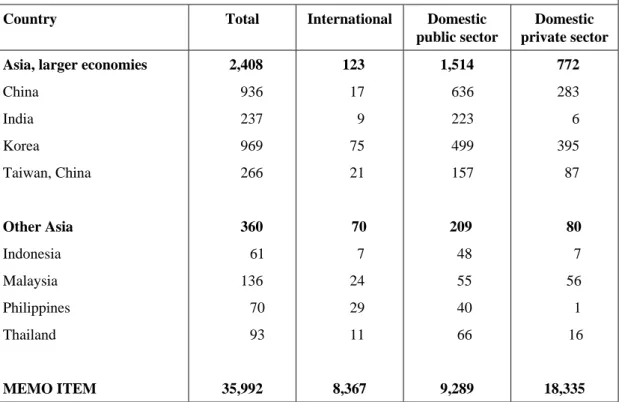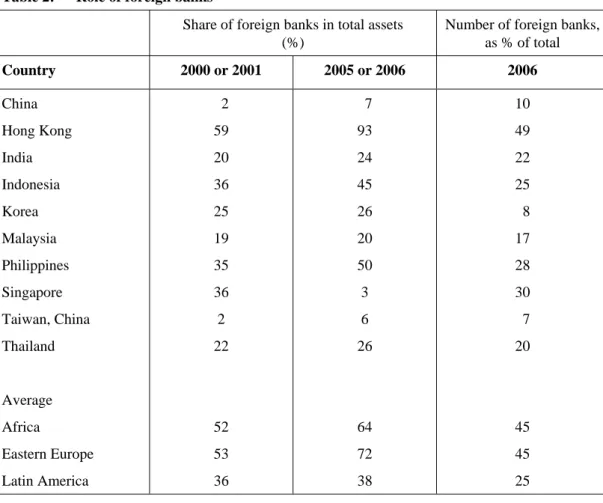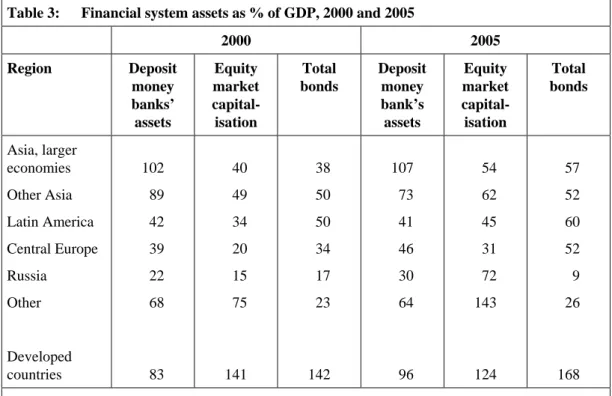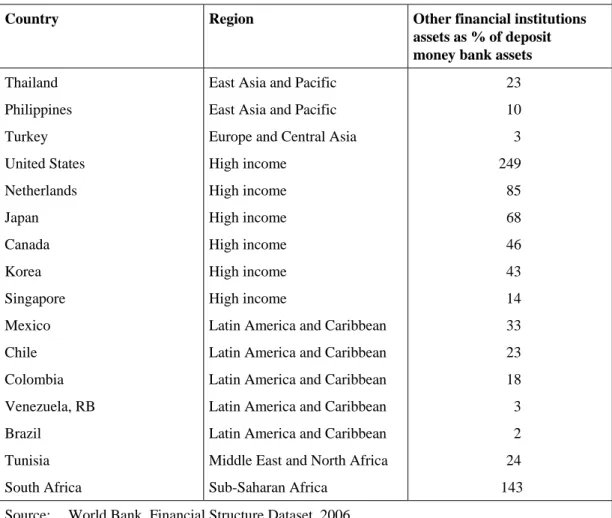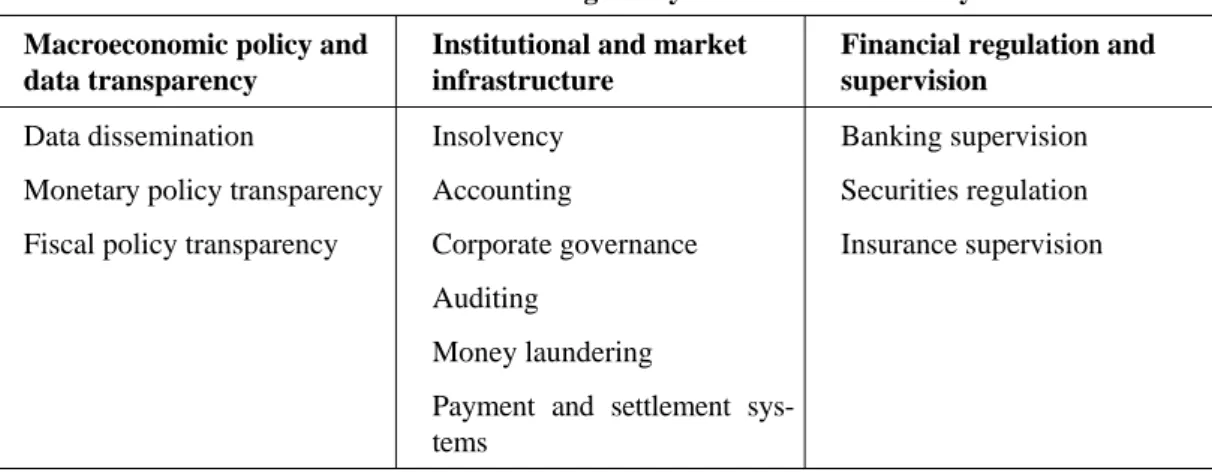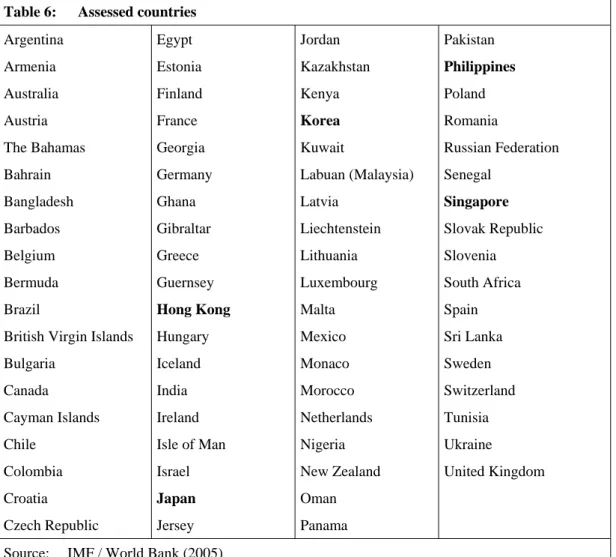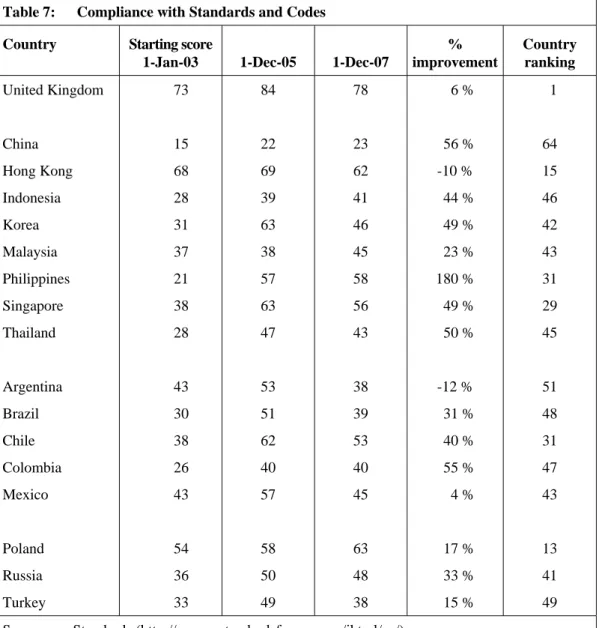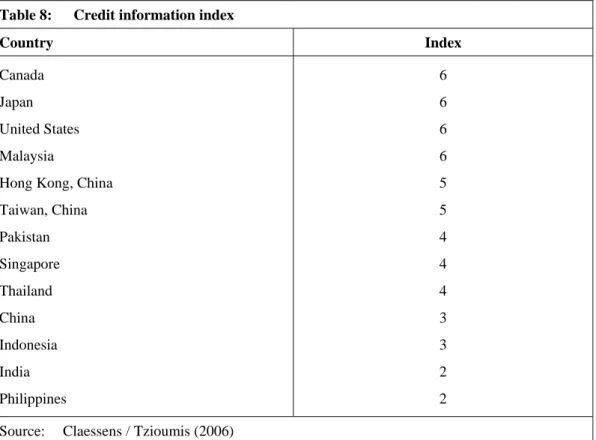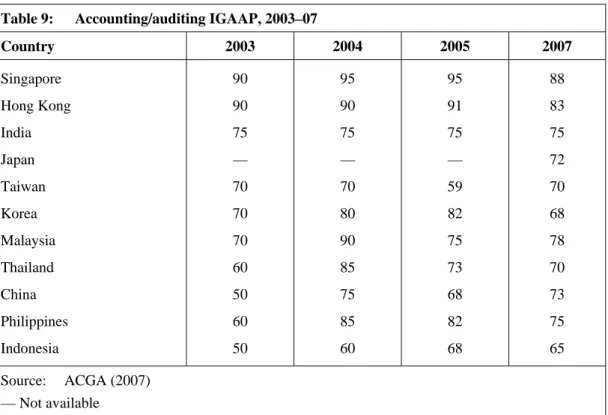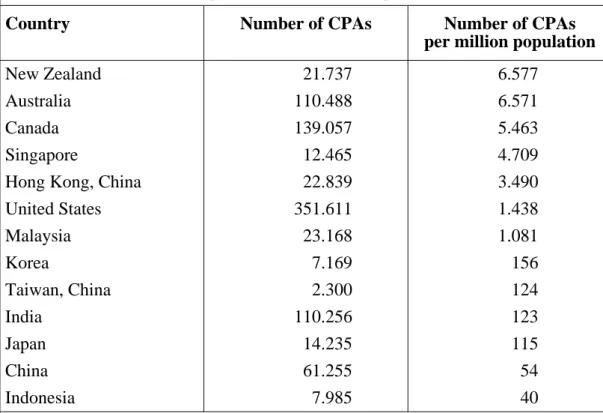Developing Regional Financial Markets - The Case of East Asia
Michael Pomerleano
Developing regional financial markets – the case of East Asia
Michael Pomerleano
Bonn 2008
Pomerleano, Michael: Developing regional financial markets : the case of East Asia / Michael Pomerleano. – Bonn : DIE, 2008. – (Discussion Paper / Deutsches Institut für Entwicklungspolitik ; 18/2008)
ISBN: 978-3-88985-406-3
Dr. Michael Pomerlenao is Advisor to the Bank of Israel, on external service from the World Bank.
E-Mail: mpomerleano@worldbank.org
An earlier version of this paper was prepared for and presented at the German Development Institute’s confer- ence on “Regional Economic Integration Beyond Europe” in Bonn, 19–20 December 2007. This conference was organised as part of the German Development Institute’s research programme “Anchor countries as drivers of regional economic integration – Consequences for regional and global governance, and for developing coun- tries”, financed by the German Federal Ministry for Economic Cooperation and Development.
© Deutsches Institut für Entwicklungspolitik gGmbH Tulpenfeld 6, 53113 Bonn
℡ +49 (0)228 94927-0 +49 (0)228 94927-130 E-Mail: die@die-gdi.de http://www.die-gdi.de
The paper explores the extent and benefits of financial integration in East Asia. It presents evidence that the extent of financial integration in East Asia is less extensive than the ag- gregate data suggests. The paper then addresses why some countries are integrated more than others and discusses the obstacles to regional financial integration. The paper points out that East Asia’s growth strategy has shaped bank centric financial systems. An impor- tant thesis presented in the paper is that reliance on bank-based intermediation has hin- dered financial integration. The prospects for regional financial integration would be im- proved greatly if governments would step back from the tradition of massive government involvement and allow market forces to play a greater role. The paper finally explores what can be done to improve the process of regional financial integration. A simple first step will be to harmonise the regulatory framework for non bank financial institutions.
Abbreviations
1 Introduction 1
2 Motivation: the benefits of and need for regional financial integration
in East Asia 2
3 What is the present level of integration in East Asia? 5
4 What hinders financial integration in East Asia? 8
5 How to facilitate regional financial integration? 12
6 Conclusions 19
Bibliography 23
(in billions of US dollars) 4
Table 2: Role of foreign banks 7
Table 3: Financial system assets as % of GDP, 2000 and 2005 10 Table 4: Other financial institution assets as % of deposit money bank assets 11 Table 5: Critical Standards and Codes designed by the Financial Stability Forum 13
Table 6: Assessed countries 14
Table 7: Compliance with standards and codes 15
Table 8: Credit information index 16
Table 9: Accounting/auditing IGAAP, 2003–07 17
Table 10: Number of certified public accountants per million 20
ABF Asian Bond Fund
ACGA Asian Corporate Governance Association ASEAN Association of South East Asian Nations BIS Bank for International Settlements CMI Chiang Mai Initiative
EMEAP Executives’ Meeting of East-Asia and Pacific Central Banks
EU European Union
FSAP Financial Sector Assessment Program
GDP Gross Domestic Product
IMF International Monetary Fund
MiFID Markets in Financial Instruments Directive ROSCs Reports on the Observance of Standards and Codes
1 Introduction
In the late 1990s, the Asian crisis was a stark reminder of what happens when bank- ing systems are weak. While the crisis had numerous causes, a major one was short- term capital flows, which contributed to currency and duration mismatches on the balance sheet of the banking and corporate sectors. Clearly the bank-centric finan- cial systems in Indonesia, Korea, and Thailand paid a very high price: Indonesia’s crisis in 1997–98 was one of the costliest in the world, and more than 50 % of Gross Domestic Product (GDP) was spent to bail out the banking sector. As is well known, the crisis was associated with major macroeconomic disruptions, including sharp increases in interest rates, large currency depreciations, output collapses, and lasting declines in the supply of credit. The collapse of the financial sector severely re- stricted growth, and the average income of Indonesians has yet to reach the levels before the crisis.
As a result of this experience, the policy community accords far greater importance to sound financial integration in economic development. According to a recent paper from the International Monetary Fund (IMF 2007), financial globalisation has in- creased dramatically over the past three decades, bringing numerous theoretical benefits. This trend has been particularly pronounced in advanced economies and more moderate in developing countries. The empirical benefits are evident in coun- tries with well-developed domestic financial systems. However, the process of inte- gration is nuanced, depending heavily on the existence of a strong financial sector and sound prudential policies. In light of the Asian crisis, it is not surprising to find that countries with a weak financial sector (particularly in banking) seem more likely to suffer crisis than countries that improved their prudential policies before liberalising the financial account. Financial integration leads to increased volatility in developing countries that lack robust financial systems and do not have a high degree of institutional quality. Similarly, countries need firm macro foundations. As expected, countries with current account deficits, rising inflation, and expansionary fiscal policies seem more likely to suffer a currency or debt crisis than countries with low current account deficits, low inflation, and solid public finances.
I am grateful to the organisers of this conference for giving me the opportunity to reflect on this issue. Given my operational experience during the Asian financial cri- sis, my interest in the topic is very pragmatic. This paper accepts the extent and benefits of financial integration and addresses two questions: Why are some coun- tries integrated more than others? and What can be done to improve the process of regional financial integration? The term ‘financial integration’ as used in this paper applies to the integration of financial markets – that is, the extent of foreign invest- ment in domestic financial markets and access to foreign financial products.
A distinction needs to be made between capital account liberalisation and converti- bility, which refers to the freedom with which capital inflows and outflows of vary- ing nature and maturities are allowed to move across borders. In fact, domestic de- regulation, market opening, and capital account convertibility do not have to march in lockstep. A country does not have to lift restrictions on the capital account before deregulating its domestic financial markets and permitting foreign participation. In fact, there is considerable evidence (IMF 2007) that domestic financial systems can
benefit from foreign participation, and there is professional agreement that robust domestic financial systems are a precursor to opening up the capital account.
The paper is structured as follows. Section 2 briefly motivates the discussion by re- viewing the need for and potential benefits of regional financial integration. Section 3 presents evidence on the extent of financial integration in East Asia. Section 4 dis- cusses the obstacles to regional financial integration. In particular, it points out that East Asia’s growth strategy has shaped countries’ financial systems. An important thesis presented in the paper is that the East Asian growth model, in which policy makers “govern the market” by relying on bank-based intermediation, has hindered integration. The prospects for regional financial integration would be improved greatly if governments would step back from the tradition of massive government involvement and allow market forces to play a greater role. Section 5 discusses the preconditions for regional integration and offers recommendations to accelerate the integration process in East Asia. Further, based on the analysis of East Asian finan- cial integration, it highlights policy implications for other regions. Section 6 con- cludes.
2 Motivation: the benefits of and need for regional financial integration in East Asia
The macroeconomic arguments favouring financial integration are well known.
Broadly speaking, financial globalisation should enhance international risk sharing, reduce macroeconomic volatility, and foster economic growth. First, financial inte- gration implies that the allocation of capital is optimal, leading to improved eco- nomic efficiency. As argued in Feldstein / Horioka (1980), if financial integration is sufficiently advanced and capital is perfectly mobile, the correlation between domes- tic investment and savings should be low. International financial integration permits portfolio diversification: capital flows to the highest risk-adjusted returns and, in the process, risk-adjusted expected rates of return tend to equalise across countries.
Equally, as theory suggests and empirical evidence documents, financial integration brings intangible benefits. First, it leads to development of the domestic financial sector and facilitates the adoption of international best practices in accounting, fi- nancial regulation, and supervision. Foreign ownership of banks facilitates the trans- fer of credit assessment technology and risk management techniques. The issuance of external debt exposes countries to the scrutiny of credit-rating agencies and the market discipline of investors. Financial integration may improve policy discipline and signal a country’s commitment to sound policies.
Recent evidence on the benefits of regional financial integration is presented in sev- eral studies. The Bank for International Settlements (BIS 2004; 2005) shows how foreign investment has brought efficiency and stability to emerging markets. An im- portant benefit is the improvement in financial sector efficiency that arises from local banks’ exposure to global competition. Generally, host countries benefit from the technology transfers and innovations in products and processes commonly associ- ated with the entry of foreign banks. Foreign banks exert competitive pressures, bring demonstration effects, and transfer technology to local institutions, often in-
ducing them to improve their risk management, offer more competitive pricing, and allocate credit more efficiently. Foreign banks also help to achieve greater financial stability in host countries. Host countries may benefit immediately from foreign en- try if foreign banks recapitalise weak domestic institutions and, in the process, pro- vide needed balance-of-payments support. The better capitalisation and wider diver- sification of foreign banks, along with the provision of access to parent funding for local operations, may reduce the sensitivity of the host-country banking system to local business cycles and changing financial market conditions. The adoption of risk-based credit evaluation tends to reduce lending risks, and, in times of financial distress, a globally diversified bank has the headroom to recognise losses and re- solve problems in a timely fashion.
In designing policy on the entry of foreign financial institutions, it is important to realise that multinational banks tend to emphasise lines of business that complement the services of local banks by following global clients into emerging markets.
Pomerleano / Vojta (2001) examine the behaviour of the largest multinational or global banks. These institutions are capable of offering cutting-edge global plat- forms for wholesale services, generally at lower cost than purely domestic banks.
Allowing global institutions to enter a market brings much greater competitive pres- sure on local banks to reach new domestic clients and thereby deepens the range of financial services available.
However, East Asia confronts the following paradox. Since 2002, official reserves in East Asia have grown at an unprecedented rate, mainly as a by-product of official efforts to resist currency appreciation. Those official reserves have been invested largely in low-yielding foreign assets. At the same time, private capital is flowing into the region from financial centres in Europe and the United States. While some of the outflows from East Asia are consistent with prudent portfolio diversification, outflows are sizeable, suggesting that East Asia does not have the capacity to inter- mediate financial flows. Therefore, East Asian financial intermediation is carried offshore. At the same time that East Asian savings are channelled abroad, there are vast unmet investment needs in the region. Among the major challenges facing East Asia are inadequate infrastructure (for example, transport and power) and lack of access to basic social services (for example, potable water, sanitation, education, and health care). Equally the explosive industrialisation has led to environmental degra- dation, which requires massive investments in environmental cleanup. The infra- structure needs in East Asia are estimated at approximately US$ 200 billion annually over the next five years, or a total of US$ 1 trillion according to the Asian Develop- ment Bank, the Japan Bank for International Cooperation, and the World Bank (2005). Much of this infrastructure financing will have to come from local and inter- national capital markets.
Do local financial markets have the capacity to mobilise those resources? Table 1 presents the size of the domestic bond markets in select Asian countries. Local bond markets differ greatly in size, domestic institutional demand, liquidity, and support- ing infrastructure. However, all of the bond markets in East Asian economies are dominated by government bonds and do not appear deep enough to handle the re- gional need for infrastructure. Equally, the range of instruments required for infra- structure financing appears inadequate. Securitisation – essential for infrastructure –
is still a frontier asset class, representing only 3 % (US$ 120 billion) of the emerging fixed-income markets. Therefore, it is not likely that the domestic markets will be able to mobilise US$ 1 trillion over the next five years. Meeting those financing needs will require far better-functioning local capital markets and non-bank financial institutions capable of intermediating those savings in the East Asian region. Sup- portive evidence comes from Sheng (2006a; 2006b), who argues that, despite the lessons of the Asian crisis and efforts to develop bond and equity markets, Asian financial systems remain bank-dominated, with fledgling bond markets, speculative stock markets, and small insurance and pension systems. Sheng’s message is that, even though economic fundamentals and the resilience of Asian financial systems have improved, financial integration is proceeding slower than trade integration and regulatory and other barriers still hinder integration.
How can the gap between the savings available and the infrastructure investment needed be explained? A possible explanation is that the East Asian financial systems do not possess adequate local instruments to absorb and intermediate the high level of savings in East Asia. For example, Caballero (2006) argues that there is a short- age of financial assets in emerging markets. The supply in emerging markets is not keeping up with the wealth created and the demand for stores of value, and collat- eral. Therefore, the surplus savings are placed with U.S. and European financial in- termediaries. Those savings are recycled back into East Asia in the form of foreign portfolio investment and foreign direct investment.
Table 1: Total debt outstanding in selected Asian countries in 2005 (in billions of US dollars)
Country Total International Domestic
public sector
Domestic private sector Asia, larger economies
China India Korea Taiwan, China
Other Asia Indonesia Malaysia Philippines Thailand
MEMO ITEM
2,408 936 237 969 266
360 61 136 70 93
35,992
123 17 9 75 21
70 7 24 29 11
8,367
1,514 636 223 499 157
209 48 55 40 66 9,289
772 283 6 395 87
80 7 56 1 16
18,335 Sources: Committee on the Global Financial System, BIS (http//www.bis.org/cgfs/index.htm) Memorandum item: Australia, Belgium, Canada, Germany, Hong Kong SAR, Singapore, Spain,
United Kingdom, United States
An apparent paradox in financial services is that, despite the fact that finance is ab- stract and deals with products and that the revolution in communications has made physical location irrelevant, financial firms continue to be spatially concentrated in the same regional financial centres (the City in London and Manhattan in New York) and even in the same blocks in those cities. This suggests that geography mat- ters for financial firms. Why? Two arguments favour regional financial integration.
First, recent empirical research provides ample evidence that information asymme- tries appear to increase in distance. For example, in a recent paper (Rose / Spiegel 2007) find that remoteness from financial activity, as measured by the distance to major international financial centres, increases macroeconomic volatility. They ex- plain it by information asymmetry – distance leads to opaqueness.
Second, research points out that a great deal of knowledge is created and transmitted in the context of communities of practice linked by common norms of communica- tion and rules. An ‘epistemic culture’ is the term that researchers use to describe communities identified with the process of creating knowledge. Such work-based communities share common cognitive frames and rules governing the creation, vali- dation, and selection of knowledge. Considerable research has been done on epis- temic communities and the development of local knowledge. Several recent studies have shown that proximity among collaborators is positively associated with innova- tion among knowledge-intensive small firms (Gittelman 2003).
Similarly, the combination of several intertwined favourable factors – complemen- tary products, epistemic local communities, and suitable regulation – create the criti- cal mass for competitive financial centres. Similarly, the agglomerations of financial firms in a particular region are conducive to the development, accumulation, and preservation of local knowledge and lead to financial deepening. The physical pres- ence of financial firms in the East Asian region is likely to provide a platform for the diffusion of skills and expertise and the exploitation of local knowledge that is not possible from afar. The previous discussion helps to clarify the benefits of regional and global integration. The local knowledge argument suggests that regional integra- tion and global integration are complementary – regional integration brings the benefits of global integration locally. In this context, regional integration offers a venue through which to reach critical mass in meeting East Asia’s need for financial services in East Asia.
3 What is the present level of integration in East Asia?
Several forces are leading to increasing financial integration. First, East Asia has emerged as a third area of trade integration, following the European Union (EU) and the North American Free Trade Agreement. Intra-Asian trade has risen from 34.6 to 54.5 % of the region’s total world trade over the last quarter century (Sheng 2006b).
East Asian trade is driven by the manufacturing global supply chain. In this context, deeper regional financial integration is likely to follow trade integration. Second, domestic policies in East Asian economies have moved away from ‘governing the market’ to relying on market forces. Third, there is a paradigm shift from a bank- dominated to a market-based financial world. Finally, East Asian economies are be-
coming more affluent. All of these trends bode well for regional and global financial integration.
How is financial integration defined and measured? Quantifying the extent of finan- cial integration is a multifaceted concept, usually referring to the size of gross stocks of external assets and liabilities, the potential for large net flows (that is, differences between savings and investment flows), and the absence of opportunities for arbi- trage between returns on assets in different countries. The most widely accepted measure of financial integration, presented in Lane / Milesi-Ferretti (2006), is the extent to which countries are linked through cross-border financial holdings (meas- ured by the sum of countries’ gross external assets and liabilities relative to GDP).
According to Mauro / Ostry (2007) financial globalisation, measured by gross exter- nal assets and liabilities relative to a country's GDP, has approximately tripled since the mid-1970s. High-income countries account for most of the increase. In low- and middle-income countries, average increases have been more moderate. Within this group, however, there is substantial variation. Countries in East Asia have, on aver- age, experienced a sixfold increase. However, the measure has limitations. Gross external assets and liabilities relative to a country's GDP might not be indicative of private financial sector integration in Asia. In East Asia capital outflows are ac- counted for by the official sector’s investment of reserves. These are primarily in long-term dollar- and euro-denominated assets and account for roughly 65 % of all capital outflows from the region. By contrast, private investors account for the ma- jority of capital outflows from Europe and the United States.
Following on Feldstein / Horioka (1980), another measure of financial integration uses correlations between savings and investment to measure the degree of interna- tional financial integration for groups of countries in different historical periods. Fi- nally, comparisons of prospective returns on financial instruments in different coun- tries (for example, covered or uncovered interest parity) provide a natural gauge of the extent of international financial integration. These measures also have limita- tions, which are not discussed here.
What about financial integration in East Asia? Recent evidence is found in a paper by García-Herrero / Wooldridge (2007), which reviews the progress of global and regional integration in emerging markets. The quantitative data point to significant integration over the past decade. The authors find that new members of the Euro- pean Union (EU) have reached a very high level of financial integration, comparable in some respects to that of more mature economies. García-Herrero and Wooldridge attribute the high level of regional integration in Europe to the common institutional and regulatory framework provided by the European Union, together with the moti- vation of joining the Euro Area. Regional financial integration in Latin American countries lags behind that in the new EU members. The situation in Asia is some- where in-between that of Latin America and Europe. It should be noted as well that capital flows within the East Asian region remain surprisingly small, particularly in the context of growing trade links and integrated supply chains. Most cross-border holdings are distributed among the three big global financial centres: the United States, the United Kingdom, and the Euro Area. Equally the cross-border outflows of East Asian countries are official reserves, while the inflows are mainly private flows from those three centres.
Recent Bankscope quantitative data document the rapid entry of foreign firms into the financial sectors of emerging markets in the last few years, especially in banking.
In Latin America, the foreign bank share of total assets rose from 34 % in 2001 to 38 % in 2006. In Eastern Europe, the foreign bank share rose from 48 % in 2001 to 72 % in 2006 (BIS 2006). In Asia – particularly in China and India – the foreign share of total assets lags behind (see Table 2).
Qualitative evidence regarding financial integration comes from a recent Bank for International Settlements (BIS) report (BIS 2006), which documents structural changes in emerging markets. Banking systems in emerging economies have been transformed by privatisation, consolidation, and foreign bank entry. More recently, reforms appear to have slowed, in part because the easy work has been done. For example, rather than engaging in full-scale privatisation, countries like China and India are only gradually transferring ownership of major state-owned banks to the private sector. Bank consolidation has been market driven, and foreign banks are playing an important role in Central and Eastern Europe and in Mexico, while the state is playing a larger role in Asia.
Table 2: Role of foreign banks
Share of foreign banks in total assets (%)
Number of foreign banks, as % of total Country 2000 or 2001 2005 or 2006 2006 China
Hong Kong India Indonesia Korea Malaysia Philippines Singapore Taiwan, China Thailand
Average Africa
Eastern Europe Latin America
2 59 20 36 25 19 35 36 2 22
52 53 36
7 93 24 45 26 20 50 3 6 26
64 72 38
10 49 22 25 8 17 28 30 7 20
45 45 25 Source: Bankscope
Note: Foreign banks: companies with ultimate owners of shareholders (owning together 51 %) located in another country (including subsidiaries within a country).
The papers in Open Doors: Foreign Participation in Financial Systems (Litan / Masson / Pomerleano 2001) provide corroborative evidence of the growing presence of foreign firms in key parts of the financial sectors in the developing world, al- though Asia and Africa lag significantly behind other emerging markets. The papers also document the important benefits that foreign firms bring to the markets they enter: added investment, cutting-edge technologies, better managerial practices (es- pecially risk management), and, because they tend to be more diversified than local institutions, more financial stability. At the same time, the papers note that the glob- alisation of finance raises new policy issues that must be addressed, particularly in the coordination of regulation and supervision across national borders.
Recent papers point out that capital markets in East Asia are not important. The stock markets in Indonesia, the Philippines, and Thailand have modestly low abso- lute and relative market capitalisation (to GDP) and low capital mobilization and turnover. Weak legal protections for minority shareholders and limited development of institutional investors have limited the free float (percentage of shares owned by the public), and a large percentage of shares are closely held. For instance, in Indo- nesia, as in a number of East Asian countries, many of the companies are family- owned businesses that float only a small proportion of stock. They tend to be man- aged as family entities, raising concerns about the rights of minority shareholders.
For the top 20 companies by market capitalization, the free float is only approxi- mately 36.4 % (World Bank 2006). Pitsilis / Sheng / Twiss (2007) write that the in- dependent exchanges of Southeast Asia, with their lower liquidity and subscale trad- ing and clearing facilities, face a serious risk of being marginalised, with detrimental effects on capital market development. They write that, while stock markets can be expected to grow in most East Asian economies, their absolute size is bound to re- main small relative to world or regional stock markets, inflicting competitive disad- vantages. The lack of local competitiveness is encouraging stock market activity to migrate to international financial centres. The Balkanisation of Southeast Asia’s ex- changes stands in contrast to the global trends of consolidation. Pitsilis et al. attrib- ute the lack of integration to conflicting national agendas and regulatory hurdles.
They argue that policy makers should pursue long-term reforms and regional har- monisation efforts that would considerably enhance the long-term outlook for re- gional capital markets and their chance to remain credible fund-raising venues for the best companies in the Association of South East Asian Nations (ASEAN).
4 What hinders financial integration in East Asia?
One explanation points to the myriad regulatory restrictions that have stifled trade and investment in financial services. Several papers point to limited progress in World Trade Organization negotiations on freer cross-border trade and foreign entry in financial services. Sauvè / Steinfatt (2001) take a cautionary view of the progress of trade and investment in financial services. They find strong indications that trade agreements were used primarily to consolidate and “lock in” the status quo rather than to promote further market opening and stimulate the process of domestic regu- latory reform. Considerable barriers to trade in financial services are embedded in domestic regulatory practices. Many countries maintain a multitude of trade and in-
vestment measures that hinder foreign participation under the guise of limiting sys- temic risk. Dobson (2002) cautions as well that the significance of the 1997 Finan- cial Services Agreement should not be overstated. Dobson’s paper discusses the ap- parent paradox between the long-term promise of financial sector reform and the reluctance of developing countries to open their financial markets: “Neither the OECD countries ... nor developing countries ... made commitments amounting to much further market opening beyond the status quo.” Schott (2008) expresses doubts regarding the prospects for multilateral trade agreements. There are many reasons why the Doha Round has progressed so slowly, but by and large Schott thinks that the fragmentation of players is leading to failure. The recent slowdown in the global economy does not bode well for prospective trade agreements.1
Others point to domestic regulatory and institutional weaknesses that hinder integra- tion as well. Barton (2007) argues that the Asian financial system could become world class if its regulatory systems, economic ministries, and financial institutions would improve dramatically. The transition would be made easier if East Asia would develop as a more integrated financial market, with a degree of coordination and specialisation (for example, regional bond markets and consolidation of local exchanges).
However, the thesis presented in this paper is that the East Asian model of growth – predicated on ‘governing the market’ – is the major impediment to integration. How has the East Asian growth strategy shaped the East Asian financial systems? East Asia’s financial system is a direct by-product of the East Asian development model.
Wade (1990) persuasively argues that the predominant approach to economic policy in the 1950s and 1960s in East Asia stressed the links between corporations, banks, and governments and assigned a substantial role to the state in ‘repairing’ perceived market failures. East Asian policy makers distrusted market-based intermediation and based their countries’ development models on a directed-credit approach of intermediating savings from the public through banks to businesses. The channelling of household savings by banks to corporates led to a bank-dominated financial sys- tem as opposed to a more market-based financial system. Therefore, domestic finan- cial systems are bank based, and the participation of non-bank financial institutions in domestic systems is insignificant. Clinical evidence is offered in Hahm’s (2005) discussion of the Korean banking system. The case study provides corroborative evidence for the directed-credit model. Korea’s first major step toward financial lib- eralisation was to reprivatise commercial banks in 1981. While bank ownership was transferred to the private sector, government continued to intervene, both directly
1 However, there is room for optimism that bilateral trade agreements can accelerate progress. The recent progress in financial services liberalisation via bilateral agreements undertaken by the United States is indicative of this potential. In bilateral trade agreements, the United States pur- sues comprehensive free trade agreements in financial services. The United States offers national treatment in financial services to the governments of emerging-market economies that provide reciprocal market access. Since 2004, the United States has completed and implemented 10 free trade agreements. The pending Korea-U.S. Free Trade Agreement is illustrative of other bilateral agreements.
(for example, through selective credit policies for heavy and chemical industries) and indirectly (for example, through controls over the allocation of bank credit), throughout the 1980s and early 1990s. Equally, the government continued to influ- ence corporate investment decisions by controlling the governance of commercial banks. Prior to the crisis, the chief executive officers of publicly listed banks were appointed by the Ministry of Finance and Economy.
Therefore, the evidence suggests that bank-dominated systems are far more oriented to domestic growth strategies than market-based systems. Typically, domestic banks are well entrenched and reliant on long-term “name” relationships. Even leading banks in the region are domestically oriented and have not made headway in creat- ing a broad-based regional financial institution. Singapore’s DBS Group Holdings is Southeast Asia's largest banking group. DBS Bank’s stated goal in September 2000 was to become a world-class regional bank. However, the bank has not achieved its regional objectives, possibly due to nationalistic factors. Recently, Temasek said that, as a result of rising nationalism on sovereign-wealth investments, it would no longer seek controlling interests in companies outside Singapore (“Temasek, Re- verse Charges,” The Economist, 2007). Similarly, Kookmin Bank, South Korea’s biggest lender, does not appear motivated by a regional strategy.
Quantitative evidence documents as well that Asia’s financial system was and still is bank based. Table 3 desegregates the Asian financial system by bank credit to the private sector, stock market capitalisation, and total bonds outstanding.Total finan-
Table 3: Financial system assets as % of GDP, 2000 and 2005
2000 2005 Region Deposit
money banks’
assets
Equity market capital-
isation
Total bonds
Deposit money bank’s assets
Equity market capital-
isation
Total bonds
Asia, larger economies Other Asia Latin America Central Europe Russia
Other
Developed countries
102 89 42 39 22 68
83
40 49 34 20 15 75
141
38 50 50 34 17 23
142
107 73 41 46 30 64
96
54 62 45 31 72 143
124
57 52 60 52 9 26
168 Sources: Datastream; IMF; Standard & Poor’s; World Bank; BIS
Note: Deposit money banks’ assets refer (whenever available) to the claims on the private sector, non-financial public enterprises and central and local governments (lines 22a, 22b, 22c and 22d of the IMF’s International Financial Statistics). Total bonds include domestic money market instruments (table 2a of the CGFS questionnaire), domestic bonds and notes, and in- ternational bonds, notes, and money market instruments from the BIS database.
cial assets in Asia were about 202 % of GDP in 2005, while the level of financial assets in developed economies was 388 % of GDP that the same year. However, 44 % of Asia’s financial assets were in the banking system. By comparison, banking assets accounted for only 25 % of total assets in the financial sector in developed economies. At the extreme, in Indonesia, the banking sector still controls nearly 72 % of financial assets. Supportive evidence is presented in Table 4. While in the United States the assets of other financial institutions are 249 % of deposit money bank assets, in Thailand they are only 23 %, and 10 % in the Philippines.
Sheng (2006a), who has been active in financial sector reform in East Asia for the past 30 years, argues that the lack of institutional development in East Asia’s non- bank financial sector has led to inefficient intermediation and poor risk management.
A more diversified financial sector would contribute to East Asian growth. The sec- tor of non-bank financial institutions – notably, equity and bond markets, mutual funds, pension funds, insurance companies, and other institutions, such as venture capital and leasing companies – have important roles to play in the East Asian economies but are lagging behind. First, by ensuring contestability, a diversified fi- nancial system offers competition to the banking system, and non-bank financial in- stitutions that compete with financial intermediaries can foster rapid market devel- opment. A wider range of financial products would benefit East Asia as well. The private sector needs different types of capital: risk capital from capital markets,
Table 4: Other financial institution assets as % of deposit money bank assets
Country Region Other financial institutions assets as % of deposit money bank assets Thailand
Philippines Turkey United States Netherlands Japan Canada Korea Singapore Mexico Chile Colombia Venezuela, RB Brazil
Tunisia South Africa
East Asia and Pacific East Asia and Pacific Europe and Central Asia High income
High income High income High income High income High income
Latin America and Caribbean Latin America and Caribbean Latin America and Caribbean Latin America and Caribbean Latin America and Caribbean Middle East and North Africa Sub-Saharan Africa
23 10 3 249 85 68 46 43 14 33 23 18 3 2 24 143 Source: World Bank, Financial Structure Dataset, 2006
short-term financing from banks, as well as longer-term financing through capital markets and institutional investors.
Banks obtain most of their funding from deposits, and prudent asset-liability man- agement says that banks should offer only short-term, floating-rate loans. Therefore, banks are not a source of long-term capital. Leasing and factoring services could help to provide term funding for the private sector, especially small and medium en- terprises, which are often constrained by the lack of collateral. Private sector-led economic growth also requires well-functioning equity and corporate bond markets to serve as sources of risk capital. At present, the capital markets in East Asia (with the exception of China) do not mobilise adequate risk capital. The potential for growth of the equity markets in East Asia is significant, but decisive policies are needed to reach the full potential of the market. As previously discussed, East Asia is in dire need of infrastructure. Long-term bond markets could improve the inter- mediation between savings and investments, while providing long-term domestic financing for infrastructure. Institutional investors such as mutual funds, pension funds, and insurance companies are a critical source of demand for bonds. However, the base of institutional investors is small. For instance, the pension industry con- trols assets equal to less than 4.5 % of GDP in Indonesia and 8.4 % in Thailand, compared with Malaysia (57 %) and Australia (75 %). There is great potential to mobilise domestic resources through pension funds. The insurance sector has the potential to contribute to the long-term investment needs of East Asia; however, in East Asia the insurance sector is small as well. In Indonesia, for example, it consti- tutes just 4.3 % of GDP and is highly concentrated.
5 How to facilitate regional financial integration?
What measures are warranted to motivate and facilitate more rapid financial integra- tion? De Brouwer (1999) discusses different methods for assessing the openness of a country's financial system to domestic and international influences and applies these tests to 10 countries in East Asia. He suggests that East Asia should adopt a phased approach to regional integration, with some of the more developed markets like Australia, Hong Kong, Japan, and Singapore working to attain free trade in services in the financial area first. In other words, East Asia should strive for a gradual proc- ess that first pursues cooperation and only then considers integration.
Sheng (2002) offers a complementary approach, firmly rooted in institutional eco- nomics: “If we want to be part of the global market, one has to play by global rules and standards. This is the biggest lesson from Africa and Latin America.” Global rules and standards are basically like a common language. After the Asian crisis, countries in the region suffered from myriad weaknesses in institutional infrastruc- ture, including poor regulation as well as inadequate corporate governance, weak auditing and accounting standards, and inadequate bankruptcy law. For instance, Barth / Caprio / Levine (2006) argue that developing countries need to place far more emphasis on policies, such as disclosure requirements, that promote market discipline. East Asian countries have undertaken a range of remedial measures to establish sound foundations for financial markets, such as an improved regulatory framework and enhanced supervision. Clearly, adequate infrastructure – standards
and codes, complemented by a robust regulatory framework – is needed to improve the functioning of financial systems. Therefore, it is important to examine the pro- gress that East Asian countries have made in adopting international standards and codes. One way to measure progress is to assess the convergence of countries to the
‘international highway’ developed by the international financial community. The standards and codes initiative was launched in 1999 by the Financial Stability Forum to strengthen the international financial architecture. The initiative covers 12 areas and associated standards, which are recognised as essential to financial stability.
These standards relate to policy transparency, financial sector regulation and super- vision, and market integrity (see Table 5). Reports on the Observance of Standards and Codes (ROSCs) covering financial sector standards are prepared under the In- ternational Monetary Fund and World Bank Financial Sector Assessment Program (FSAP). The FSAP seeks to identify the strengths and vulnerabilities of a country’s financial system, to determine how key sources of risk are being managed, to ascer- tain the sector’s developmental needs, and to prioritise policy responses.
It is noteworthy that East Asian countries have not been particularly engaged in the FSAP. Countries such as China, Indonesia, Malaysia, and Thailand, while systemi- cally important, have not been assessed (see Table 6). This information by itself might suggest that there is room for greater transparency in East Asia. Nevertheless, the findings from other FSAPs are instructive: in many developing countries (and this is not unique to East Asia), the underdevelopment of sectors such as securities markets, insurance, and contractual savings restricts the types of financial services offered (IMF / World Bank 2005).
How much progress have East Asian countries made in adhering to the international standards and codes? The ROSCs are published only occasionally at the request of the member country. Therefore, we have to rely on information in the public do- main. eStandards has been monitoring countries’ progress in adopting and imple- menting international standards and codes established by the global standard-setting authorities. The compliance assessments rely exclusively on publicly available in- formation, and the scores in each area and the averages are updated monthly as a result of a constant review of developments within each country. It is instructive to review the results, subject to the usual caveat. Those quantitative scores are, by their
Table 5: Critical Standards and Codes designed by the Financial Stability Forum Macroeconomic policy and
data transparency
Institutional and market infrastructure
Financial regulation and supervision
Data dissemination
Monetary policy transparency Fiscal policy transparency
Insolvency Accounting
Corporate governance Auditing
Money laundering
Payment and settlement sys- tems
Banking supervision Securities regulation Insurance supervision
Source: Financial Stability Forum (http://www.fsforum.org/cos/key_standards.htm)
nature, subjective and mask vast qualitative differences; moreover, information in the public domain is limited as well as of short duration. Having said that, using the average score across the 12 areas, representative countries selected for the sample made progress during the period (see Table 7). China, the Philippines, and Thailand improved their average score the most. Malaysia achieved modest improvement.
Some countries (Hong Kong, Korea, and Singapore) even regressed, ending with a score lower than the maximum score achieved during the period. In reviewing the individual categories, the scores for macroeconomic fundamentals were relatively high to begin with and improved further during the period for all countries, espe- cially in the area of data dissemination. The scores for institutional and market infra- structure were lower than those for macroeconomic fundamentals in all countries. In financial regulation and supervision, progress was uneven among and within coun- tries. The findings are not surprising: first, efforts to address macro stability prac- tices are the foundation for all other efforts, and second, micro institutional changes are far more dependent on institutional capacity and skills that are in short supply.
Therefore, progress in areas such as financial regulation and supervision and institu- tional infrastructure is lagging.
Table 6: Assessed countries Argentina
Armenia Australia Austria The Bahamas Bahrain Bangladesh Barbados Belgium Bermuda Brazil
British Virgin Islands Bulgaria
Canada
Cayman Islands Chile
Colombia Croatia
Czech Republic
Egypt Estonia Finland France Georgia Germany Ghana Gibraltar Greece Guernsey Hong Kong Hungary Iceland India Ireland Isle of Man Israel Japan Jersey
Jordan Kazakhstan Kenya Korea Kuwait
Labuan (Malaysia) Latvia
Liechtenstein Lithuania Luxembourg Malta Mexico Monaco Morocco Netherlands Nigeria New Zealand Oman Panama
Pakistan Philippines Poland Romania
Russian Federation Senegal
Singapore Slovak Republic Slovenia South Africa Spain Sri Lanka Sweden Switzerland Tunisia Ukraine
United Kingdom
Source: IMF / World Bank (2005)
A vast literature finds that countries with better legal regimes have deeper financial systems (La Porta et al. 1998). Equally, improving the quality, comparability, and transparency of financial information is crucial for facilitating the operation of inter- nal markets as well as for strengthening the economic links between countries. In- formation indicative of inadequate transparency comes from several sources. Draw- ing from the World Bank’s Doing Business database (2005), Claessens / Tzioumis (2006) provide country rankings in a credit information index. This index measures rules affecting the scope, access, and quality of credit information. It ranges from 6 to 0, with higher values representing better institutional environment. The rankings are presented in Table 8. As can be seen, Malaysia is on a par with Canada, Japan, and the United States, while the Philippines ranks last at 2. The findings indicate that there is considerable room for improvement.
Table 7: Compliance with Standards and Codes Country Starting score
1-Jan-03 1-Dec-05 1-Dec-07
% improvement
Country ranking United Kingdom
China Hong Kong Indonesia Korea Malaysia Philippines Singapore Thailand
Argentina Brazil Chile Colombia Mexico
Poland Russia Turkey
73
15 68 28 31 37 21 38 28
43 30 38 26 43
54 36 33
84
22 69 39 63 38 57 63 47
53 51 62 40 57
58 50 49
78
23 62 41 46 45 58 56 43
38 39 53 40 45
63 48 38
6 %
56 % -10 % 44 % 49 % 23 % 180 % 49 % 50 %
-12 % 31 % 40 % 55 % 4 %
17 % 33 % 15 %
1
64 15 46 42 43 31 29 45
51 48 31 47 43
13 41 49 Source: eStandards (http://www.estandardsforum.com/jhtml/ca/)
Complementary evidence regarding governance and transparency comes from the Asian Corporate Governance Association (ACGA). The linkages between corporate governance and financial disclosure policies are well known. Strong corporate gov- ernance can serve to support credible financial disclosure. ACGA has designed a system for rating+ countries on their corporate governance2. The findings from the
“CG Watch 2007” report (ACGA 2007) are not encouraging. The pace of reform has slackened (see Table 9), raising a warning flag that economic successes are fostering complacency. The report speculates that political paralysis (for example, Korea) or upheaval (for example, Thailand) has slowed the pace of reforms. The report docu- ments regional improvements in auditing standards and practices but notes that ac- counting and auditing standards and practices lag international norms more than ex- pected in many Asian markets.
2 A detailed survey of about 80 questions assesses the extent to which markets are meeting interna- tional standards of corporate governance in five categories: rules and regulations (15 %), en- forcement (both by the market and by the regulators, 25 %), political and regulatory environment (20 %), international accounting and auditing standards (20 %), and corporate governance culture (20 %). It covers not only the practices on paper but also their implementation. Each question re- ceives an answer of yes, no, somewhat, or marginally, with a score of one point, zero, half a point, or a quarter of a point, respectively, for each answer. The score of each category is a sim- ple average of all answers to the questions in that category; the total score for a country is a weighted average score over five categories.
Table 8: Credit information index
Country Index Canada
Japan United States Malaysia
Hong Kong, China Taiwan, China Pakistan Singapore Thailand China Indonesia India Philippines
6 6 6 6 5 5 4 4 4 3 3 2 2 Source: Claessens / Tzioumis (2006)
As previously discussed, adherence to standards and codes needs to be comple- mented by a sound legal regulatory framework. As noted by García-Herrero / Wooldridge (2007), the new members of the EU come closest to achieving an inte- grated market. A possible explanation for their rapid integration is the common in- stitutional and regulatory framework provided through EU directives, together with the desire to join the Euro Area. The push toward a single market in services in the EU focuses on harmonising wholesale financial services, such as inter-bank pay- ment systems, and on areas in which benefits could be won fairly quickly, such as government bond and equity markets. Both factors have resulted in extensive cross- border financial ties. For instance, the key EU investment services directive sets conditions for a single EU-wide license for investment firms, which empowers stock exchanges to operate across borders. In November 2007 the EU introduced the Mar- kets in Financial Instruments Directive (MiFID). The MiFID aims to reshape the fi- nancial markets in Europe by creating a common market for share, commodities, and derivatives trading across 30 countries in Europe. MiFID's objectives – in- creased transparency and reduced costs for the users of financial instruments such as equities, bonds, and derivatives – will be pursued through standardised rules on the dissemination of quotes, on pre- and post-trade transparency, as well as on “best execution” practices. The new rules end the monopoly of national stock exchanges over the trading of shares and open the field to newer electronic exchanges. As a re- sult, the traditional business model of established exchanges is going to be chal- lenged as never before. Such European initiatives give an example of how to push for greater financial integration in East Asia.
There is evidence of progress in improving the regulatory framework in East Asian countries, reflected as well in the progress made by East Asian banks in addressing their past vulnerabilities. Turner (2006) reports that the Asian crisis stimulated major
Table 9: Accounting/auditing IGAAP, 2003–07
Country 2003 2004 2005 2007
Singapore Hong Kong India Japan Taiwan Korea Malaysia Thailand China Philippines Indonesia
90 90 75
— 70 70 70 60 50 60 50
95 90 75
— 70 80 90 85 75 85 60
95 91 75
— 59 82 75 73 68 82 68
88 83 75 72 70 68 78 70 73 75 65 Source: ACGA (2007)
— Not available
structural changes in the banking systems in some countries, and there is good evi- dence of stronger performance. Despite the improvements, he concludes that there are still several signs of inefficiency and poor risk management practices.
However, there is equal evidence that East Asian countries are lagging in the devel- opment of an effective regulatory regime for non-bank financial institutions. For in- stance, Carvajal / Elliott (2007) use the evidence from the FSAPs to assess securities regulatory systems, examine problem areas, and explore regional trends. They find that a consistent theme emerges regarding the inability of regulators in many coun- tries to enforce compliance with existing rules and regulations. A combination of factors, including lack of power and authority, lack of resources and skills, and lack of political will, have undermined the regulators’ ability to regulate effectively.
How much progress have East Asian countries made in the regulatory framework and regional cooperation? While the desire for cooperation is evident, regional co- operation in East Asia is narrow. In May 2000, the finance ministers of ASEAN+3 countries reached agreement on the Chiang Mai Initiative (CMI), which was the first significant regional financing arrangement that enabled countries to cope with dis- ruptive capital flows and maintain stable exchange rates. Under the CMI, member banks are allowed to swap their own currencies for major international currencies for a period of up to six months. The CMI was designed to expand the existing ASEAN Swap Arrangement, by extending its coverage to all members of ASEAN and increasing the size of the swap arrangements, and to create a network of bilateral swap agreements between the countries of ASEAN+3.
The Asian Bond Funds is another notable initiative. The EMEAP (Executives’
Meeting of East-Asia and Pacific Central Banks) Group, comprising 11 central banks and monetary authorities in the East Asia and Pacific region, launched two Asian Bond Funds (ABF1 and ABF2). The Asian Bond Funds are important steps in fostering regional cooperation in Asia. ABF1 invests in U.S. dollar-denominated bonds issued by sovereign and quasi-sovereign issuers in EMEAP economies. The ABF2 invests in domestic currency bonds issued by sovereign and quasi-sovereign issuers in the eight EMEAP markets. The initiative facilitates the reinvestment of a small portion of East Asia's reserves back into the region, while at the same time catalysing the development of regional capital markets. A primary objective of the ABF2 is to harmonise market practices and drive regulatory reforms leading to re- gional convergence. Harmonisation in domestic markets benefits all issuers and in- vestors in the region. For example, at the regional level, EMEAP economies are cur- rently reviewing or changing their tax and regulatory regimes to facilitate cross- border investment. At the domestic level, some economies are actively developing the relevant regulations to permit exchange-traded bond funds, which are innovative products targeting retail and institutional investors. Nevertheless, regional coopera- tive efforts clearly need to redouble.
In the introduction to the paper I stated that section 5 will highlight policy implica- tions for other regions based on the analysis of East Asian financial integration. At the risk of repeating the obvious, the most important conclusion is not surprising:
regional financial integration starts at home with reforms designed to strengthen the infrastructure of the financial sector and harmonise regulatory frameworks. Such
efforts can be complemented in Africa and Latin American with regional initiatives such as EMEAP’s Asia Bond Fund initiative. In fact in my discussions with policy makers in the respective regions, there was considerable interest in such initiatives.
Still, as important such initiatives are, the focus has to be put the domestic financial system in order.
6 Conclusions
This paper has presented evidence that East Asia needs to focus its efforts in several areas. The lesson from the Asian crisis and the recent subprime crisis in the United States is that systemic risks need to be addressed at home. In this context, domestic reforms will yield the greatest returns. Domestic reforms are the most promising venue to accelerate regional financial integration. What are the priorities? Foremost, there is a need for a change in mind-set. The process of regional financial integration would be greatly improved if governments would step back from the tradition of government involvement in bank-based systems and allow market forces and non- bank financial institutions to play a far greater role. Structural financial reforms need to remain front and centre on the policy agenda. Regional governments need to re- duce state ownership, build solid infrastructure, and improve the information infra- structure and technology to reduce intermediation costs, provide limited safety nets, and use incentives to induce better market monitoring. In short, the big changes still have to come within the East Asian countries themselves.
Financial integration benefits from sound domestic financial systems, and govern- ments need to strengthen the clout of supervisors. Improving the regulation of non- bank financial institutions is important. For that, East Asian financial policy makers need to redouble the efforts to develop the non-bank financial institutions sector within a sound and coherent regulatory regime. While banking regulation and super- vision have improved throughout the region, added attention needs to be paid to the regulatory and supervisory framework for non-bank financial institutions. Equally, East Asian countries need to make substantial progress in institutional development along the lines prescribed by the international standards and codes.
In parallel, regional regulators should seek to improve cooperation between national regulators and adopt common standards in more areas, such as disclosure, govern- ance, and insolvency. The authorities need to improve the acceptance of interna- tional standards and liberalise foreign entry into the domestic financial sector through foreign direct investment and financial services. Equally, national regulators ought to be more transparent with one another and share best practices. For example, modest steps toward regional cooperation could be undertaken under the auspices of regional bodies, such as the Asia-Pacific Regional Committee of the International Organization of Securities Commissions. East Asia could start with modest steps:
harmonisation efforts could include consistent and modern listing requirements for the regional exchanges and a single prospectus for issuers (single “passport”) for stock markets. In the future, East Asia could consider reaching an agreement along the lines of the key EU investment services directive, which sets conditions for a single EU-wide license for investment firms and empowers stock exchanges to op- erate across borders.
